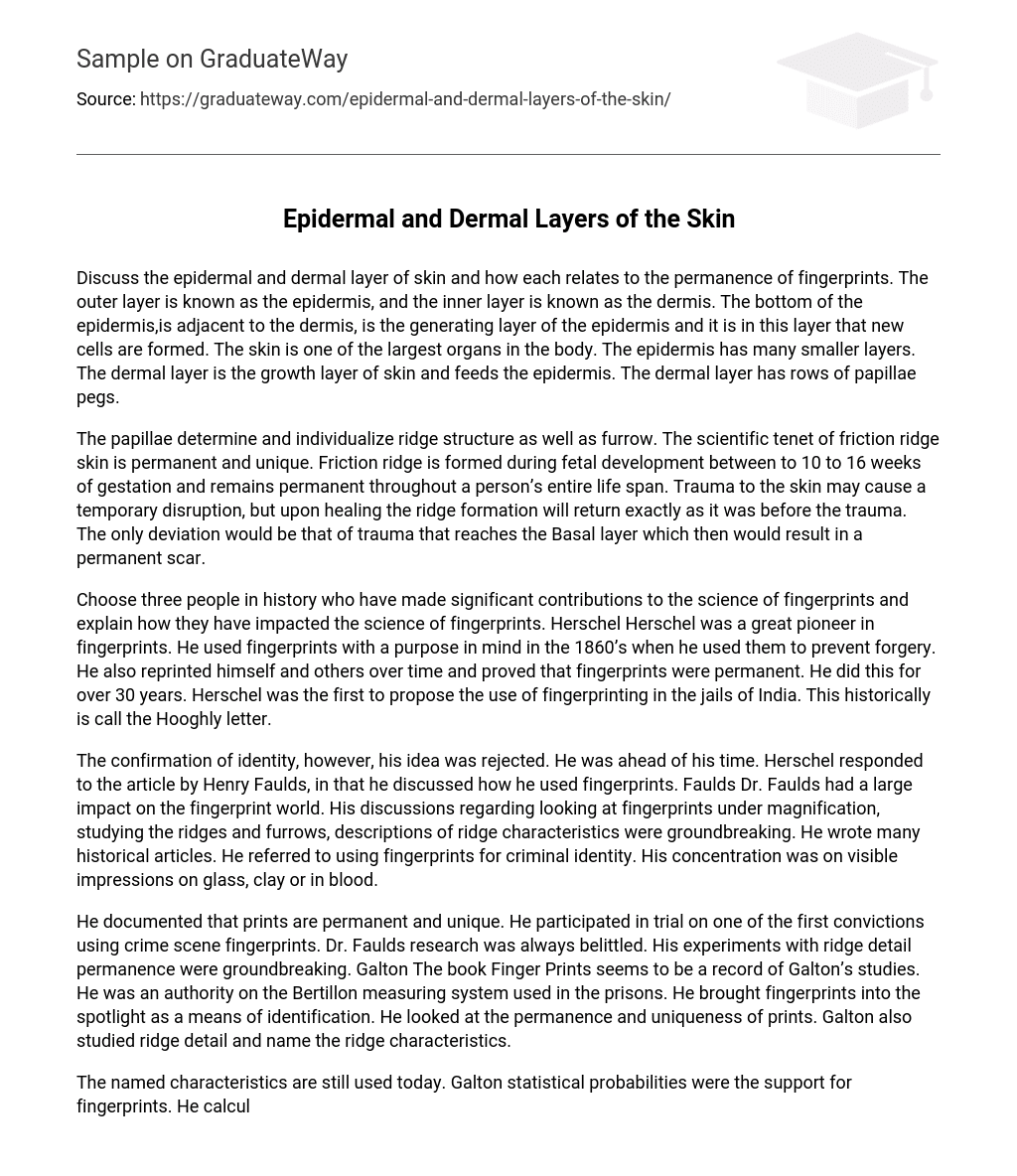Discuss the epidermal and dermal layer of skin and how each relates to the permanence of fingerprints. The outer layer is known as the epidermis, and the inner layer is known as the dermis. The bottom of the epidermis,is adjacent to the dermis, is the generating layer of the epidermis and it is in this layer that new cells are formed. The skin is one of the largest organs in the body. The epidermis has many smaller layers. The dermal layer is the growth layer of skin and feeds the epidermis. The dermal layer has rows of papillae pegs.
The papillae determine and individualize ridge structure as well as furrow. The scientific tenet of friction ridge skin is permanent and unique. Friction ridge is formed during fetal development between to 10 to 16 weeks of gestation and remains permanent throughout a person’s entire life span. Trauma to the skin may cause a temporary disruption, but upon healing the ridge formation will return exactly as it was before the trauma. The only deviation would be that of trauma that reaches the Basal layer which then would result in a permanent scar.
Choose three people in history who have made significant contributions to the science of fingerprints and explain how they have impacted the science of fingerprints. Herschel Herschel was a great pioneer in fingerprints. He used fingerprints with a purpose in mind in the 1860’s when he used them to prevent forgery. He also reprinted himself and others over time and proved that fingerprints were permanent. He did this for over 30 years. Herschel was the first to propose the use of fingerprinting in the jails of India. This historically is call the Hooghly letter.
The confirmation of identity, however, his idea was rejected. He was ahead of his time. Herschel responded to the article by Henry Faulds, in that he discussed how he used fingerprints. Faulds Dr. Faulds had a large impact on the fingerprint world. His discussions regarding looking at fingerprints under magnification, studying the ridges and furrows, descriptions of ridge characteristics were groundbreaking. He wrote many historical articles. He referred to using fingerprints for criminal identity. His concentration was on visible impressions on glass, clay or in blood.
He documented that prints are permanent and unique. He participated in trial on one of the first convictions using crime scene fingerprints. Dr. Faulds research was always belittled. His experiments with ridge detail permanence were groundbreaking. Galton The book Finger Prints seems to be a record of Galton’s studies. He was an authority on the Bertillon measuring system used in the prisons. He brought fingerprints into the spotlight as a means of identification. He looked at the permanence and uniqueness of prints. Galton also studied ridge detail and name the ridge characteristics.
The named characteristics are still used today. Galton statistical probabilities were the support for fingerprints. He calculated that the chance of a duplicate print was 1 to 4 times the population of the earth. What is the scientific method, and how is this theory applied to fingerprint analysis? Scientific method is a process of observable, repeatable and validation in a process. It applies to prints in the ACE-V process. ACE-V stands for Analysis, Comparison, Evaluation and Verification. In the analysis phase I am looking at the print for clarity, if it has value for comparison and the friction ridge features.
I am looking at level one detail and level two for clarity. In the Comparison phase I am looking at the known print and the crime scene print. I am comparing them side by side to see if the print is identification or not. I am looking at Level one two and three detail. In the evaluation phase I am coming to a conclusion. I am either going to identify, exclude or find the prints inconclusive. In the verification phase, another fully trained competent examiner goes through the ACE process to see if there is verification. Arriving at the same conclusion.





